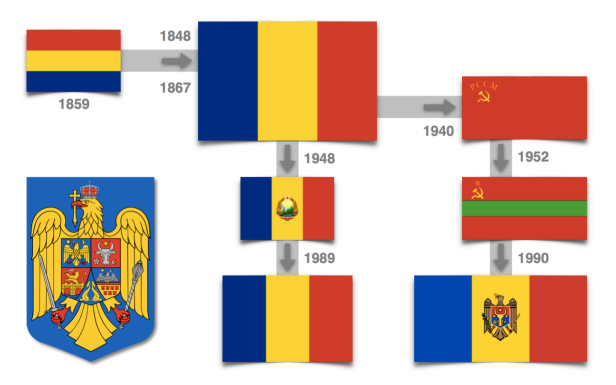
Romania and the Republic of Moldova used to be the same country. They share the same cultural and heraldic traditions, and Romanian is the official language of both countries. So, it is not difficult to understand why the Romanian and Moldovan flags look so much alike. Here is a short history of the national flags of “the Romanian lands”.
The Romanian national colours are blue, yellow and red. They stem from the heraldry of the two medieval Romanian principalities Moldavia and Wallachia.
The coat of arms of Moldavia is red, with an aurochs’s head, a rose, a crescent and a star, all in gold. The coat of arms of Wallachia is blue, with an eagle, a cross in its beek, a sun and a crescent, all in gold.
Around 1500, “the Romanian lands” became vassals of the Ottoman Empire. In 1812, following one of the many Russo-Turkish Wars, the eastern half of Moldavia was ceded to the Russian Empire. This territory is also known as Bessarabia.
Moldavia and Wallachia became the United Principalities in 1859. Even though the Ottomans didn’t recognize their right to do so, the United Principalities used a red-yellow-blue horizontal tricolour as national flag.
From 1866, the country’s official name is Romania. The Romanian Assembly of Deputies decided in 1867 on the flag design which is still in use: a blue-yellow-red vertical tricolour. This flag had also been used in 1848 by the nationalist and liberal revolutionaries opposed to Ottoman rule and Russian influence.
Finally, in 1877, Romania became fully independant of the Ottoman Empire, and in 1881, Romania was updated to a kingdom.
Following World War 1, the country’s territory was greatly enlarged as lands previously under the Russian Empire (Bessarabia) and the Austro-Hungarian Empire (Transylvania and parts of the Banat and Hungary) were united with Romania.
An ultimatum from the Soviet Union, the USSR, to Romania in 1940 forced Romania to give up Bessarabia and the Communist regime established the Moldavian Socialist Soviet Republic with a majority Moldavian, i.e. Romanian, population. The Moldavian SSR used a USSR style red flag similar to other Soviet republics.
For three years during World War 2, Bessarabia came back in Romanian hands. First, Romania joined Germany’s attack on the Soviet Union in 1941. Later, in 1944, the Soviet Red Army reconquered the area and reestablished the Moldavian SSR.
Backed by the Red Army, Communists took over in Romania and abolished the monarchy. The Romanian People’s Republic changed the Romanian flag in 1948: a USSR style coat of arms with a red star was added to the flag’s yellow stripe.
In 1952, during a reform of the flags of Soviet republics, the Moldavian SSR got a new flag: a red-green-red horizontal tricolour with the USSR’s golden hammer and sickle in the upper inner corner of the flag.
In 1989, widespread protests lead to the fall of Nicolae Ceaușescu, Romania’s Communist dictator for almost 25 years. Romanians cut the Communist coat of arms out the national flag.
In 1990, the Supreme Soviet of the Moldavian SSR adopted the present national flag of Moldova. The flag is similar to that of Romania: a blue-yellow-red vertical tricolour; the flag of Moldova has the Moldovan national coat of arms in the centre.
Moldova declared its independence from the Soviet Union in 1991. Possible unification of Romania and Moldova has enjoyed some support in both countries.
Since 2007, Romania is part of the European Union. For the moment, Moldova doesn’t consider itself a candidate for EU membership. The issue of Transnistria, a Moldovan breakaway republic where Russians are the largest ethnic group, is still unresolved. These facts alone make a unification of “the Romanian lands” unlikely for the foreseeable future.
By the way, Transnistria, officially known as the Pridnestrovian Moldavian Republic, still uses the 1952 flag of the Moldavian SSR.